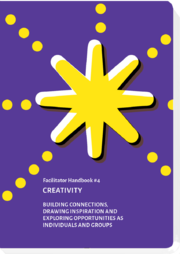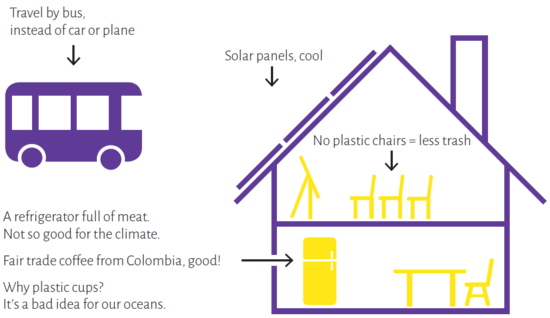|
|
| (14 intermediate revisions by 3 users not shown) |
| Line 1: |
Line 1: |
| − | ==Pupils develop a global map that emerges from a reflection of their everyday life at school.== | + | __NOTOC__ |
| | + | <div class="teaser-text">Participants develop a global map from reflecting on their everyday life and how it irelates to a globally relevant topic, for example, CO2 pollution.</div> |
| | + | <div class=methodpage-infos> |
| | + | <hr class=simpleline> |
| | + | [[File:Time-icon.png | 20px | Time]] 1-2 hours |
| | | | |
| − | ==Goal and Learning Objective==
| + | [[File:Material-icon.png | 20px | Material ]] paper and pens for creating the map, maybe photos |
| | | | |
| − | The pupils become aware of the global dimension of their personal items and things. Their networked and cross-linked thinking is strengthened as well as their competence in critical thinking.
| + | [[File:Group-size.png | 20px | Group Size ]] 15-35 people |
| | | | |
| − | ==Time== | + | [[File:Keywords.png | 20px | Keywords ]] global interconnections, fairness, human rights, wealth |
| | + | <hr class=simpleline> |
| | + | ===From:=== |
| | + | [[File:Suedwind.png | link=https://suedwind.at]] |
| | + | <hr class=simpleline> |
| | | | |
| − | 1-3 hours (dependening on the intensity)
| + | ===Related:=== |
| | + | * [[Global Learning]] |
| | + | *[[Unleashing Creativity]] |
| | + | <hr class="simpleline"> |
| | + | <div class=left-box> |
| | + | [[File:Creativity-book-cover.png |180px | link=Handbooks for Facilitators]] |
| | + | N. Zimmermann, E. Leondieva, M. Gawinek-Dagargulia |
| | + | ===Creativity=== |
| | + | Fourth Handbook for Facilitators: [[Handbooks for Facilitators | Read more]] |
| | | | |
| − | ==Materials and Ressources==
| + | </div> |
| | + | </div> |
| | | | |
| − | room, paper and pens for creating the map, maybe photos
| + | <div class=methodpage-content> |
| | | | |
| − | ==Number of People== | + | ==Goal== |
| | + | * Participants become aware of the global dimensions of their personal items and things. |
| | + | * They strengthen their creative thinking by cross-linking ideas. |
| | + | * They strengthen their critical thinking ability. |
| | | | |
| − | 15-35 pupils
| + | [[File:Globalmapcompetendo.png | 550px]] |
| | | | |
| | ==Steps== | | ==Steps== |
| | + | * Ask participants to create a map of the training session, the venue or their school. |
| | + | * Add every place that they associate somehow with globalization. |
| | + | * Participants then examine their own bags, clothes, lunchbox, computer room, smartphone, the materials the venue is built with .. and reflect on how it relates to CO2 emissions or global labor inequalities. |
| | + | * Have participants sketch the items, one card per item, and write a short description of every item. |
| | + | * The whole class then attaches the cards on the big training map. |
| | + | * The leading question is: Why and in what way are these icons (products, places, histories) related to CO2 and globalization? |
| | | | |
| − | # All pupils create a map of their own school.
| + | ==Reflection== |
| − | # They add every place of their school that they associate somehow with globalisation.
| + | * Why and in what way are these icons (products, places, histories) related to CO2 and globalization? |
| − | # The pupils look after eye-catching symbols or icons for the different things. Their own schoolbag, clothes, lunchbox, computer room, smartphone, the materials the school is built with and so on.
| + | <hr class=boldline> |
| − | # The pupils write a description of every item on a card.
| + | <noinclude>{{:Block: Book: Creativity Handbook}}</noinclude> |
| − | # The whole class attaches the cards on the big map of the school. Photos and drafts can be added as well.
| |
| − | # One question is discussed all together: Why and in what way are these icons (products, places, histories) related to globalisation?
| |
| − | # The developed and by the pupils created GLOBAL MAPS can be presented in school and show how the pupils see their life connected with the world.
| |
| | | | |
| | + | <hr class=boldline> |
| | + | <noinclude>{{: Block: Author Ingrid Schwarz}}</noinclude> |
| | | | |
| − | ==Reflection and Debriefing==
| + | [[Category:Method]] |
| − | | |
| − | Please find the provided information below "Step 6".
| |
| − | | |
| − | ==Reference==
| |
| − | Dr.in Ingrid Schwarz, [Südwind NÖ SÜD I http://suedwind-noesued.at/index.php?article_id=94]
| |






